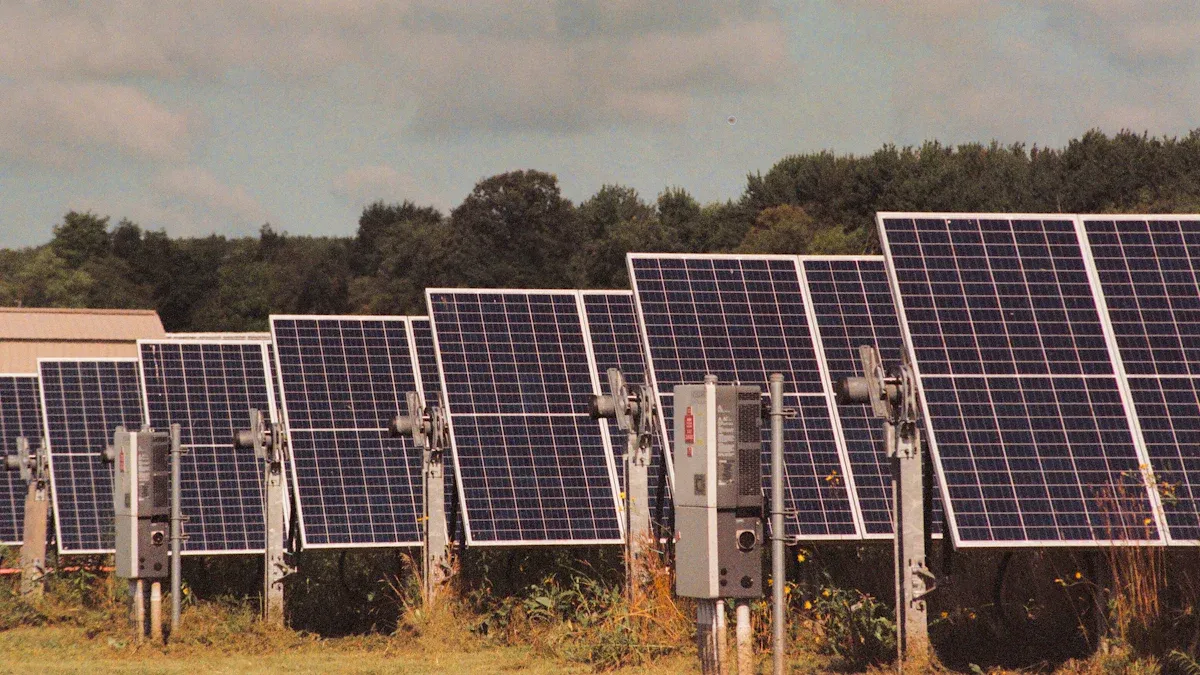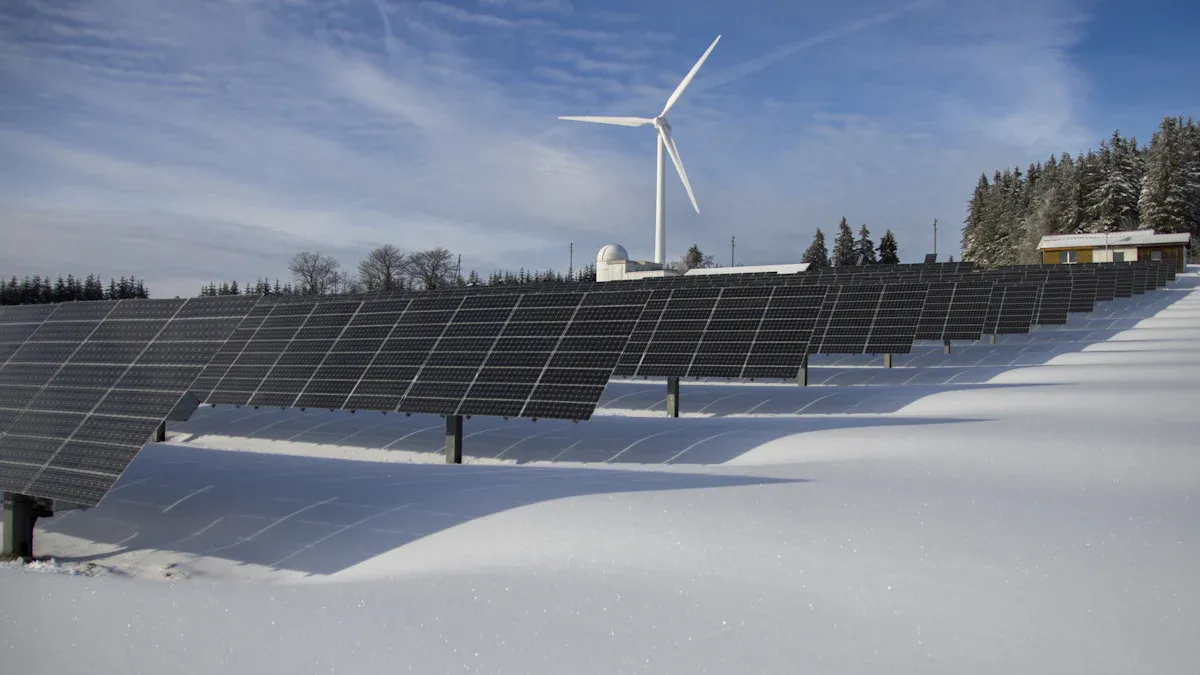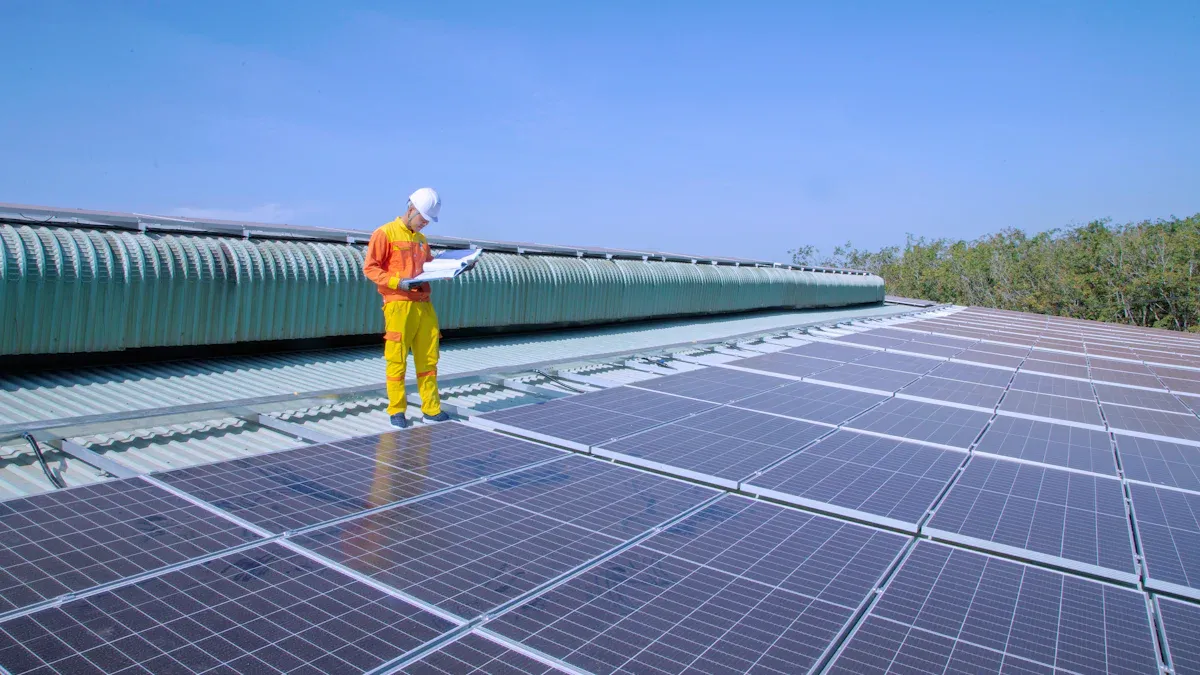Choosing the Right ESTEL PV Panels for Maximum Efficiency

When picking a solar panel, PV panel efficiency is very important. It shows how much sunlight turns into usable energy. Higher PV panel efficiency means more electricity from the same sunlight, which helps save more on energy costs.
Buying efficient ESTEL PV panels helps the planet by utilizing more solar power. Heat and pollution can affect how well solar panels work. For example, Singh and Ravindra found that hot weather lowers solar cell performance. Song et al. discovered PM2.5 pollution can cut solar energy by over 5%. Choosing the right panels with high PV panel efficiency can solve these problems and support clean energy use.
Key Takeaways
Efficient solar panels make more power from sunlight, saving money.
Pick solar panels based on how well they work: Monocrystalline panels work best, then Polycrystalline, and Thin-film panels.
Cleaning and taking care of panels helps them make more energy.
Experts should install panels to make them last longer and work well.
Look at warranties and strength when choosing ESTEL panels to keep your money safe and get energy for years.
Understanding PV Panel Efficiency

What is PV Panel Efficiency?
PV panel efficiency shows how well a solar panel turns sunlight into electricity. It is found by comparing the panel's maximum power output to its size. The formula for efficiency is:
Efficiency = ([Pmax / Area] / 1000) x 100%
Standard test conditions (STC) are used to measure this. These include a cell temperature of 25°C, sunlight strength of 1000W/m², and an air mass of 1.5. These conditions make it easier to compare panels. High-efficiency panels create more electricity from the same sunlight. This makes them great for small spaces needing maximum energy.
Why Solar Panel Efficiency Matters
Solar panel efficiency affects how well a solar system works and its cost. Panels with higher efficiency make more electricity. This means fewer panels are needed to meet energy needs. This is helpful in places with little room for installation.
Metric | Description |
|---|---|
Solar Panel Efficiency | Higher efficiency means more electricity per panel, saving money. |
Space Requirements | Lower efficiency panels need more space, raising costs. |
Energy Generation | Efficient panels use sunlight better, making more energy in small areas. |
Efficient panels also boost the performance of a solar system. For example, smart monitoring can increase energy by 3-8% yearly and cut maintenance costs by 25%. Picking high-efficiency panels gives better energy and saves money over time.
How to Measure PV Panel Efficiency
To check PV panel efficiency, look at sunlight strength, panel direction, and temperature. The power a panel makes is calculated with this formula:
P = V x I
Here, "P" is power, "V" is voltage, and "I" is current. For example, a 100W, 12V panel with 22.4 volts and 5.92 amps can make 132.6 watts in perfect conditions.
The table below shows how efficiency changes energy output:
Efficiency Rating | Energy Output Impact |
|---|---|
15% | Makes less energy |
22% | Makes more energy |
Things like location, panel angle, weather, and upkeep also affect efficiency. Checking and adjusting panels often helps them work their best and produce more energy.
Factors Influencing PV Panel Efficiency
Types of Solar Panels and Materials
The type of solar panel affects how well it works. Different materials have different abilities to turn sunlight into energy. Monocrystalline panels are made from one silicon crystal. They are the most efficient, with rates between 17% and 22%. Polycrystalline panels use many silicon pieces and have mid-level efficiency, ranging from 15% to 17%. Thin-film panels are light and bendable but less efficient, with rates between 10% and 13%.
Solar Panel Type | Efficiency Rating (%) | Performance Level |
|---|---|---|
Monocrystalline | 17% - 22% | Highest performance |
Polycrystalline | 15% - 17% | Mid-tier performance |
Thin-film | 10% - 13% | Lowest performance |
The materials also affect how well panels handle electricity. Things like current, voltage, and fill factor matter. Panels with better materials and fewer flaws work better and last longer.
Installation and Orientation
How you install and position panels is very important. Panels should face the sun for the most light during the day. In the Northern Hemisphere, south-facing panels work best. The angle of the panels also matters. If the angle is off by 9°, energy drops by 1%. If it’s off by 30°, energy drops by 10%.
Irradiance Loss (%) | Mean Tolerance Angle (°) |
|---|---|
1% | 9° |
5% | 21° |
10% | 30° |
Shadows from trees or buildings can lower energy production. Even small shadows can cause big losses. To avoid this, place panels where nothing blocks the sunlight.
Maintenance and Cleanliness
Keeping panels clean helps them work better. Dirt and dust can block sunlight and lower energy by up to 60%. This happens more in dry areas with lots of dust. Dust can also mess up how electricity flows, especially in polycrystalline panels.
To keep panels working well, follow a maintenance plan:
Autonomous Maintenance: Clean and check panels often to keep them working.
Planned Maintenance: Schedule repairs based on how often problems happen.
Quality Maintenance: Find and fix issues early to avoid bigger problems.
Pillar | Description | Benefits |
|---|---|---|
Autonomous Maintenance | Operators clean and check panels regularly. | Keeps panels clean and spots issues early. |
Planned Maintenance | Repairs are scheduled based on failure rates. | Prevents unexpected breakdowns. |
Quality Maintenance | Focuses on fixing problems early. | Saves money and avoids major issues. |
Clean and well-maintained panels will work better and last longer. This ensures your solar system stays efficient for years.
Environmental impact on efficiency
The environment affects how well solar panels work. Weather, temperature, and location change how much energy they make. Knowing these effects helps you improve your solar system's performance.
Sunny days are best for solar panels. They make more energy and attract more people to use solar power. Studies show people buy more solar panels during sunny times because they see bigger savings. But very hot weather can hurt panel efficiency. High heat makes panels too warm, lowering their ability to turn sunlight into electricity. For instance, when temperatures go above the best range, energy production drops a lot.
Clouds and rain also impact solar panels. Clouds block sunlight, so panels make less energy. Rain cleans panels but can briefly lower their output. Research shows adjusting solar systems for different weather can boost energy by 10-20%. This means even in bad weather, good adjustments can still give strong results.
Shadows are another big problem. Trees, buildings, or other objects can block sunlight and reduce energy. Even small shadows can cause big energy losses. To fix this, place panels where sunlight isn’t blocked during the day.
By thinking about these environmental factors, you can set up your solar panels better. This helps you get more energy and value from your solar investment.
How to Choose the Right ESTEL PV Panels
Identifying Energy Needs
Before picking ESTEL PV panels, know your energy use. Check your electricity bills to find your average monthly usage in kilowatt-hours (kWh). This helps you figure out how many panels you need.
Think about future energy needs too. Adding appliances, electric cars, or expanding your home will increase energy use. Plan for these changes by choosing panels that can handle both current and future needs.
Use online solar calculators or talk to a solar expert for help. These tools and professionals can match your energy needs with the right ESTEL PV panels. This ensures you save energy and avoid waste.
Comparing ESTEL Panel Efficiency Ratings
When choosing ESTEL PV panels, check their efficiency ratings. These show how well a panel turns sunlight into electricity. Higher efficiency panels make more energy from the same sunlight. They are great for small spaces.
For example, ESTEL has panels with 20%-22% efficiency. These work better than standard panels, which are 15%-18%. High-efficiency panels need fewer panels, saving space and money.
Look at the manufacturer’s datasheets for details like efficiency, temperature effects, and low-light performance. These factors show how well panels work in different conditions. Comparing these details helps you pick panels that perform well everywhere.
Balancing Cost and Efficiency
Balancing cost and efficiency is important when buying ESTEL PV panels. High-efficiency panels cost more upfront but save money over time by making more energy.
Do a cost-benefit analysis to decide. Compare the upfront cost of high-efficiency panels with the long-term savings they bring. For example:
Cost savings analysis shows how much money you’ll save.
Benefit-cost analysis looks at the overall value of your investment.
Cost-effectiveness analysis compares different panels to find the best deal.
High-efficiency panels may cost more at first, but they make more energy over time. This reduces the need for extra panels and lowers installation costs.
By focusing on long-term savings instead of just upfront costs, you can make a smart choice. This helps your wallet and the environment, giving you the best value for your ESTEL PV panels.
Reviewing warranties and durability
When picking ESTEL PV panels, check their warranties and strength. These factors protect your money and ensure the panels last long. Good warranties and strong panels give you confidence and save money over time.
Understanding Solar Panel Warranties
Solar panel warranties come in two types: product warranties and performance warranties. Each type has a specific purpose:
Product Warranty:
This covers problems like factory defects or material flaws. For example, ESTEL PV panels often have a product warranty lasting 10 to 15 years. If a panel breaks due to a defect, you can get it fixed or replaced.Performance Warranty:
This ensures the panel's energy output stays high over time. Most ESTEL panels promise at least 80% of their original efficiency after 25 years. This means your panels will still work well even decades later.
Tip: Always read the warranty details carefully. Some warranties might not cover damage from bad weather or incorrect installation.
Why Durability Matters
Durability affects how long and how well your solar panels work. Panels facing tough weather like hail, snow, or strong winds must handle these without losing efficiency. ESTEL PV panels are built with strong materials to face such challenges.
Important durability features include:
Weather Resistance: Panels should resist rust, sunlight damage, and water.
Impact Resistance: Good panels can handle hailstones up to 1 inch wide moving at 50 mph.
Temperature Tolerance: Panels should work well in both hot and cold weather.
Durability Feature | Why It’s Important |
|---|---|
Weather Resistance | Stops rust and damage from the environment. |
Impact Resistance | Protects panels from hail and flying debris. |
Temperature Tolerance | Keeps panels working in extreme heat or cold. |
How to Evaluate Warranties and Durability
To choose wisely, follow these steps:
Compare Warranty Lengths: Longer warranties mean better protection.
Read Details Carefully: Know what the warranty includes and excludes.
Look for Certifications: Certifications like IEC 61215 and IEC 61730 show safety and durability.
Ask About Testing: Trusted brands like ESTEL test their panels in tough conditions to ensure quality.
Note: A strong solar system with a good warranty ensures your panels work well for years, even in tough weather.
By focusing on warranties and durability, you can get the most from your ESTEL PV panels. This protects your investment and ensures steady energy for a long time.
Maximize Solar Panel Efficiency

Cleaning and Maintenance Practices
Cleaning solar panels is key to keeping them efficient. Dirt, dust, and bird droppings block sunlight, lowering energy production. Cleaning regularly helps panels work their best. Studies show dirt can cut efficiency by up to 25%, reducing energy savings a lot.
Dirt Level | Efficiency Drop | Yearly Loss (5-kW system) |
|---|---|---|
7% | 7% | $65 |
10% | 10% | $190 |
Up to 25% | Big drop | N/A |
Clean panels every few months or after storms. Use soft brushes and water to avoid scratches. If you live in a dusty place, hire professional cleaners. Also, check for cracks or damage while cleaning. This prevents bigger problems and keeps energy steady.
Monitoring with Smart Tools
Smart tools help you watch your solar system’s performance live. They track things like sunlight, voltage, and current. Spotting problems early lets you fix them before energy drops.
Study Name | Key Results | Tools Used |
|---|---|---|
Improved accuracy and tracked sunlight, voltage, and current. | IoT sensors, cloud tools |
Smart tools help you improve your system. For example, if shading lowers a panel’s output, the tool alerts you. This keeps panels working well, saving energy and money.
Leveraging Advanced Technologies
New technologies like solar trackers and efficient panels boost energy. Solar trackers move panels to follow the sun, raising energy by 25%-35%. High-efficiency panels, like monocrystalline ones with 18%-22% efficiency, work well even in dim light.
Taking care of inverters is also important. A good inverter changes solar energy into usable electricity. Yearly checks find hidden problems and make systems last longer. Keeping panels dry stops damage and keeps them efficient.
Using advanced tools, regular cleaning, and monitoring helps panels work their best. This gives you more energy and better savings.
Ensuring professional installation
Getting experts to install your solar panels is very important. They make sure everything is set up right for the best energy output. Proper installation helps your system work well and last a long time.
Certified installers follow rules to improve your system's performance. They test the panels to check if they are working correctly. This ensures your solar panels make as much energy as possible. If panels are not installed properly, they might not work as well.
Professionals also prevent common mistakes during installation. Wrong wiring or bad panel angles can lower energy production. Experts know how to place panels to get the most sunlight. They also secure the panels to handle tough weather.
Tip: Pick installers with trusted certifications. This shows they have the skills to do the job right.
Professional installation often includes warranties. These cover both the setup and how well the system works. If something goes wrong, the installer will fix it.
Hiring professionals makes your system more efficient and durable. When installed correctly, your solar panels will give you clean energy for many years.
Efficient ESTEL PV panels have many advantages. They use sunlight better, saving energy and lowering costs. Strong panels work well, even in tough weather. Picking high-efficiency panels helps the planet and saves money over time. 🌍💡
Check ESTEL’s efficiency ratings to choose the right panels. Talk to solar experts for advice on your home or business. Their help ensures smart choices and great results. ✅
FAQ
What makes ESTEL PV panels special?
ESTEL PV panels are unique because they are very efficient. They use strong materials and advanced technology. They work well even in dim light and have good warranties. These features help them last long and save money.
How can I figure out how many ESTEL panels I need?
Look at your monthly electricity use in kilowatt-hours (kWh). Divide this number by the energy one ESTEL panel makes. You can also use online tools or ask a solar expert for help. They can give you accurate advice based on your location.
Do ESTEL PV panels work on cloudy days?
Yes, ESTEL PV panels can still make energy when it’s cloudy. Their advanced design helps them perform well in low light. But they won’t make as much energy as on sunny days.
How often should I clean my ESTEL PV panels?
Clean your panels every three to six months or after big storms. Cleaning removes dirt and keeps them working well. If you live in a dusty area, hiring professionals can help keep them extra clean.
Are ESTEL PV panels good for small roofs?
Yes, ESTEL PV panels are great for small roofs. They are very efficient and make more energy in less space. This means you need fewer panels to meet your energy needs.
See Also
Selecting Optimal Cooling Solutions for ESTEL Telecom Cabinets
Telecom Cabinets: Utilizing Photovoltaic Energy Storage Systems
Energy Storage Solutions for ESTEL Smart Microgrid Telecom Cabinets
Telecom Cabinets with Grid-Connected Inverter and Battery Systems
In-Depth Analysis of Energy-Efficient Air Conditioning Units
CALL US DIRECTLY
86-13752765943
3A-8, SHUIWAN 1979 SQUARE (PHASE II), NO.111, TAIZI ROAD,SHUIWAN COMMUNITY, ZHAOSHANG STREET, NANSHAN DISTRICT, SHENZHEN, GUANGDONG, CHINA

